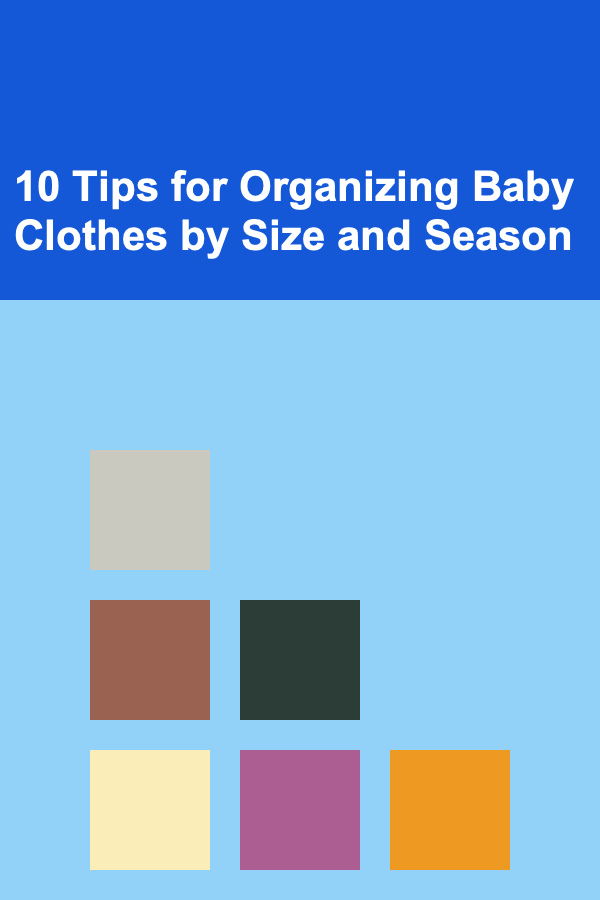
10 Tips for Organizing Baby Clothes by Size and Season
ebook include PDF & Audio bundle (Micro Guide)
$12.99$6.99
Limited Time Offer! Order within the next:

Organizing baby clothes can feel like an overwhelming task, especially with the rapid growth babies experience in their first few years. With numerous clothes in different sizes, seasonal changes, and a variety of fabrics to consider, it can be hard to know where to start. However, by adopting a systematic approach, organizing your baby's wardrobe can become an efficient and manageable task.
In this article, we will explore 10 tips to help you effectively organize your baby's clothes by size and season. This will not only make it easier to find the right outfit but also ensure that you make the most of the clothes you already have.
Sort Clothes by Size
The first step in organizing baby clothes is to sort them by size. Babies grow incredibly fast, and it's important to keep track of what fits them and what doesn't. Here's how you can go about it:
How to Sort by Size:
- Create Size Categories: Label storage bins or sections of your closet with clear categories such as "Newborn", "0-3 months", "3-6 months", "6-9 months", and so on.
- Use Dividers: If you are using a dresser, use dividers to separate the clothes into sections by size. This makes it easy to grab the right outfit for your baby without having to dig through everything.
- Check the Labeling: Clothing sizes can vary from brand to brand. Always check the brand's size guide, as some items may fit differently.
By separating clothes based on size, you can easily see what your baby currently needs and avoid overcrowding drawers or storage bins with clothes that no longer fit.
Create a Seasonal System
Baby clothes are often categorized by season, and the weather can vary greatly throughout the year. Organizing clothes by season will help you stay prepared for whatever the weather may bring. You can separate clothes by season as follows:
Seasonal Categories:
- Winter: Sweaters, jackets, warm blankets, and thicker fabrics like fleece.
- Spring/Fall: Lighter jackets, long-sleeve shirts, and pants for cooler days.
- Summer: Light dresses, t-shirts, shorts, and breathable fabrics.
Make sure to adjust your storage system as the seasons change. For example, as winter ends, pack away bulky sweaters and coats in favor of lighter, summer-friendly clothing. Use breathable storage bins or garment bags to prevent mold or mildew when storing off-season clothes.
Use Clear Storage Bins for Visibility
Clear plastic bins are one of the best ways to store baby clothes because they allow you to see what's inside without opening them. This is especially useful for outgrown clothes, as you can easily identify which sizes or seasons are stored where.
Storage Tips:
- Label Each Bin: Label bins clearly with the size, season, and gender (if necessary) for easy access.
- Stackable Bins: Invest in stackable, transparent bins to maximize vertical space, especially if you are short on storage area.
- Vacuum-Sealed Bags: For off-season clothing or outgrown items that you plan to save for future babies, vacuum-sealed bags are great at saving space while keeping clothes protected.
By using clear bins, you eliminate the need to dig through multiple containers to find the right items.
Implement a "Two-in, Two-out" Rule
As your baby grows, you will likely accumulate new clothes, either through gifts or purchases. To avoid overcrowding your baby's wardrobe and storage space, implement a "two-in, two-out" rule.
How the Rule Works:
- For every new item of clothing that comes in, donate or pass along two pieces that no longer fit or are out of season.
- This helps ensure that your baby's wardrobe stays manageable, and it allows you to get rid of items that are taking up unnecessary space.
This practice also helps in maintaining a clutter-free environment and ensures that you keep only the clothes that are useful.
Fold and Roll Clothes Efficiently
When storing baby clothes, folding and rolling can make a huge difference in saving space and keeping things neat. Rolling is particularly useful for smaller items like onesies, baby socks, or tights.
Folding Tips:
- Use a Clothing Folder: A clothing folder can help you create uniform folds that stack neatly. This is especially useful for baby t-shirts or pants.
- Rolling Technique: Roll onesies, leggings, and socks to fit them neatly into bins. Not only does this save space, but it also prevents wrinkles and helps keep everything organized.
By using the folding and rolling technique, you'll maximize storage space and ensure that you can see every item at a glance.
Create a Clothing Inventory List
Sometimes, it's difficult to remember what your baby has in their wardrobe, especially if you have multiple sizes and seasonal items stored. To keep track of what you have, create a clothing inventory list.
How to Create an Inventory:
- Take Photos: Snap photos of your baby's clothes and organize them by size and season in a digital file or folder.
- Use an App: There are several baby inventory apps that help you track your baby's wardrobe. These apps allow you to categorize, track sizes, and even make a shopping list.
- Update Regularly: As your baby grows and seasons change, update the inventory list to ensure you always know what clothes are available.
With an inventory list, you will be able to quickly assess your baby's clothing situation, and it will help you avoid buying duplicates.
Designate a "Donate or Sell" Box
As babies grow quickly, there's a constant stream of clothes being outgrown. Rather than leaving these clothes in your closet or drawer for months, designate a specific box or bin for donations or clothes to sell.
Donation Box Tips:
- Separate by Condition: Ensure you sort the clothes by their condition. Donate clothes that are still in good condition, and sell or pass on items that may have sentimental value but are no longer needed.
- Give Regularly: Schedule a regular time, perhaps every three months, to go through your baby's clothes and donate items that no longer fit or are out of season.
This helps you maintain an organized space while also ensuring that your baby's clothes get to others who may need them.
Use Dividers in Drawers
If you have a dresser for your baby's clothes, using dividers can help keep things organized and easy to access. Dividers are particularly helpful for separating smaller items such as socks, mittens, and hats.
Divider Tips:
- Adjustable Dividers: Use adjustable dividers that can grow with your baby's wardrobe. As the sizes of clothes change, you can rearrange the dividers to create new sections.
- Organize by Category: Organize your baby's clothes into categories within the drawers, such as "sleepwear," "day clothes," and "outerwear."
By using dividers, you keep clothes neatly separated, making it easier to find exactly what you need when you need it.
Maximize Closet Space
If your baby's clothing storage is in a closet, it's important to make the most of the space available. Consider using shelves, over-the-door organizers, or additional rods to create more storage.
Maximizing Closet Space:
- Install Hooks or Pegs: Use hooks or pegs to hang small items like hats, bibs, or jackets.
- Add Hanging Organizers: Consider hanging organizers for storing shoes, small toys, or seasonal accessories.
- Use Adjustable Closet Rods: Install adjustable closet rods to accommodate clothes as your baby grows. This allows you to have more hanging space for dresses or outfits.
These tips will help you optimize the closet and keep your baby's clothes neat and accessible.
Rotate Clothes Based on the Season
As the seasons change, your baby will require different types of clothing. By rotating clothes in and out of storage, you ensure that the most relevant clothes are always within reach.
Seasonal Rotation Tips:
- Use the First-In-First-Out (FIFO) Method: When packing away clothes for a new season, rotate the items that are first in line. For example, store the winter clothes at the back of the closet and bring forward lighter spring and summer clothes.
- Keep Essentials Accessible: Always keep a few of each season's essentials in easy-to-access drawers or bins, so you're not scrambling to find a summer onesie in the middle of winter.
This method helps you keep your baby's wardrobe fresh, organized, and seasonally appropriate.
Conclusion
By following these 10 tips for organizing baby clothes by size and season, you can make the task of managing your baby's wardrobe much more efficient. Sorting clothes, using clear storage bins, and rotating clothes based on the season will ensure that you always have the right outfit at hand for your growing baby. With an organized system in place, you'll also be able to minimize clutter and make better use of your space.
Reading More From Our Other Websites
- [Organization Tip 101] How to Use Color-Coding for Toy Storage Solutions
- [Soap Making Tip 101] Legal Essentials for Soap-Making Entrepreneurs: Licenses, Labels, and Liability
- [Organization Tip 101] How to Create a Color-Coded System for Your Supplies
- [Home Holiday Decoration 101] How to Achieve a Rustic Christmas Look with These Decor Ideas
- [Organization Tip 101] How to Leverage Home Staging to Increase Property Value
- [Soap Making Tip 101] DIY Detox: Step‑by‑Step Recipes for Activated Charcoal Soap Bars
- [Trail Running Tip 101] Trail Nutrition Hacks: Fueling Your Runs for Speed and Endurance
- [Weaving Tip 101] From Loom to Living Room: Turning Traditional Weaving into a Modern Business
- [Home Pet Care 101] How to Find Local Pet Grooming and Pest Control Services That Are Also Highly Rated
- [Survival Kit 101] Water Purification Tablets: How to Choose the Best Ones for Outdoor Adventures

How to Discover Advances in Concussion Treatment
Read More
How to Make a Statement with Holiday Wreaths in Your Home
Read More
How To Understand the Concept of Deliberate Practice
Read More
How to Understand AI's Role in Society
Read More
How to Find Free Financial Advice
Read More
10 Tips for Improving Walkability in Your Community
Read MoreOther Products

How to Discover Advances in Concussion Treatment
Read More
How to Make a Statement with Holiday Wreaths in Your Home
Read More
How To Understand the Concept of Deliberate Practice
Read More
How to Understand AI's Role in Society
Read More
How to Find Free Financial Advice
Read More